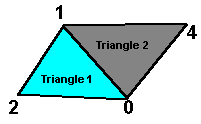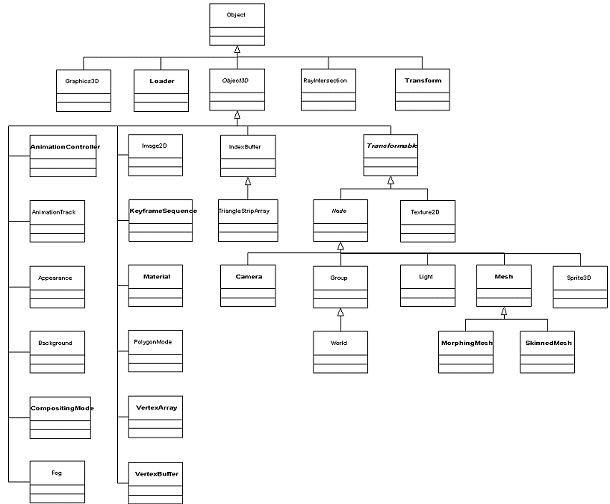|
| AnimationController |
Controls the position, speed, and weight of an animation sequence. For example, it can be used to control the blinking and movement of a light in an animation application. |
| AnimationTrack |
Associates a KeyframeSequence with an AnimationController and an animatable property, which is a scalar or vector variable that the animation system can update directly. |
| Appearance |
A set of component objects that define the rendering attributes of a Mesh or a Spring3D.
Appearance app = new Appearance();
app.setTexture(0, tex);
app.setMaterial( setMatColours() );
|
| Background |
Defines how to clear the viewport. In retained mode, or when rendering a World, the Background object associated with the World is used. In immediate mode, a Background object is given a parameter to clear. If a Background object is not present, the default values specified in the constructor are used. |
| Camera |
A scene graph node that defines the position of the viewer in the scene and the projection from 3D to 2D. The camera always faces towards the negative end of the Z axis (0, 0, -1).
Camera camera = new Camera();
float aspectRatio = ((float) getWidth()) / ((float) getHeight());
float fovy = 45.0f; //degree, not rad
float near = 0.1f;
float far = 50.0f
camera.setPerspective(fovy, aspectRatio, near, far);
|
| CompositingMode |
An Appearance component that encapsulates per-pixel compositing attributes. |
| Fog |
An Appearance component that encapsulates attributes for fogging. |
| Graphics3D |
A singleton 3D graphics context that can be bound to a rendering target. All rendering is done through the render() methods in this class.
Graphics3D g3d = Graphics3D.getInstance();
public void paint(Graphics g) {
// bind the canvas graphic to our Graphics3D object
g3d.bindTarget(g, true, Graphics3D.DITHER |
Graphics3D.TRUE_COLOR);
// position the camera
g3d.setCamera(camera, camTrans);
g3d.render(vertBuf, idxBuf, app, modelTrans);
// Flush
g3d.releaseTarget();
}
|
| Group |
A scene graph node that stores an unordered set of nodes as its children. |
| Image2D |
A two-dimensional image that can be used as a texture, background, or sprite image. There are two types: mutable images can be updated at any time; immutable images are fixed at construction time and cannot be changed later. |
| IndexBuffer |
Defines how to connect vertices to form a geometric object. |
| KeyframeSequence |
Encapsulates animation data as a sequence of time-stamped, vector-valued keyframes, each of which represents the value of an animated quantity at a specified instant. Can be associated with multiple animation targets. |
| Light |
A scene graph node that represents different kinds of light sources, which are used to determine the color of each object, according to its Material attributes.
Light light = new Light();
light.setColor(0xffffff); // white light
light.setIntensity(1.25f); // over bright
|
| Loader |
Downloads and deserializes graph nodes and node components, as well as entire scene graphs. Downloading ready-made pieces of 3D content from an M3G file is generally the most convenient way for an application to create and populate a 3D scene. |
| Material |
An Appearance component encapsulating material attributes for lighting computations. Other attributes for lighting are defined in Light, PolygonMode, and VertexBuffer.
Material mat = new Material();
mat.setColor(Material.AMBIENT, 0x00765D4D);
mat.setColor(Material.EMISSIVE, 0x00000000);
mat.setColor(Material.DIFFUSE, 0xFF876A56);
mat.setColor(Material.SPECULAR, 0x004D4D4D);
mat.setShininess(60.0f);
|
| Mesh |
A scene graph node that represents a 3D object defined as a polygonal surface. It represents a conventional rigid body mesh, and its subclasses MorphingMesh and SkinnedMesh extend it with capabilities to transform vertices independently of each other. |
| MorphingMesh |
A scene graph node that represents a vertex-morphing polygon mesh. |
| Node |
An abstract class for all scene graph nodes. There are five different kinds:
Camera defines the projection from 3D to 2D as well as the position of the viewer in the scene.
Mesh defines a 3D object consisting of triangles with associated material properties.
Sprite3D defines a screen-aligned 2D image with a position in 3D space.
Light defines the position, direction, colors, and other attributes of a light source.
Group serves as a root for scene graph branches. |
| Object3D |
An abstract base class for all objects that can be part of a 3D world. These include the world itself, other scene graph nodes, animations, textures, and so on. Everything in the API is an Object3D except Graphics3D, Loader, RayIntersection, and Transform. |
| PolygonMode |
An Appearance component encapsulating polygon-level attributes, including settings related to back/front face culling, polygon winding, lighting computations, perspective correction, and shading. |
| RayIntersection |
Stores a reference to an intersected Mesh or Sprite3D, and information about the intersection point. Strictly a run-time object, a RayIntersection is filled in by the pick() methods in the Group class, and cannot be loaded from a file by a Loader. |
| SkinnedMesh |
A scene graph node that represents a skeletally animated polygon mesh. |
| Sprite3D |
A scene graph node that represents a 2D image with a 3D position. This is a fast but functionally restricted alternative to textured geometry. It is rendered as a screen-aligned rectangular array of pixels with a constant depth. |
| Texture2D |
An Appearance component encapsulating a 2D texture image and a set of attributes specifying how the image is to be applied on sub-meshes. The attributes include wrapping, filtering, blending, and texture coordinate transformation.
Texture2D tex = new Texture2D(image2D);
tex.setFiltering(Texture2D.FILTER_NEAREST, Texture2D.FILTER_NEAREST);
tex.setWrapping(Texture2D.WRAP_CLAMP, Texture2D.WRAP_CLAMP);
tex.setWrapping(Texture2D.WRAP_REPEAT, Texture2D.WRAP_REPEAT);
tex.setBlending(Texture2D.FUNC_MODULATE);
|
| Transform |
A generic 4x4 floating-point matrix representing a transformation.
Transform camTrans = new Transform();
camTrans.postTranslate(X_CAMERA, Y_CAMERA, Z_CAMERA);
|
| Transformable |
An abstract base class for Node and Texture2D, defining common methods for manipulating node and texture transformations. |
| TriangleStripArray |
Defines an array of triangle strips. In a triangle strip, the first three vertex indices defines the first triangle. Each subsequent index together with the two previous indices defines a new triangle. For example, the strip S = (2, 0, 1, 4) defines two triangles: (2, 0, 1) and (0, 1, 4).

Number of triangles = Number of vertices - 2
|
| VertexArray |
An array of integer vectors representing vertex positions, normals, colors, or texture coordinates.
short[] verts = {0,0,0,
10,0,0,
5,10,0,
15,10,0};
VertexArray va = new VertexArray(verts.length/3, 3, 2);
va.set(0, verts.length/3, verts);
|
| VertexBuffer |
Holds references to VertexArrays that contain the positions, colors, normals, and texture coordinates for a set of vertices. |
| World |
A special Group node that is a top-level container for scene graphs. A scene graph is constructed from a hierarchy of nodes. In a complete scene graph, all nodes are ultimately connected to each other by a common root, which is a World node. |

